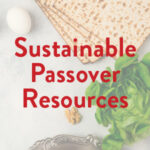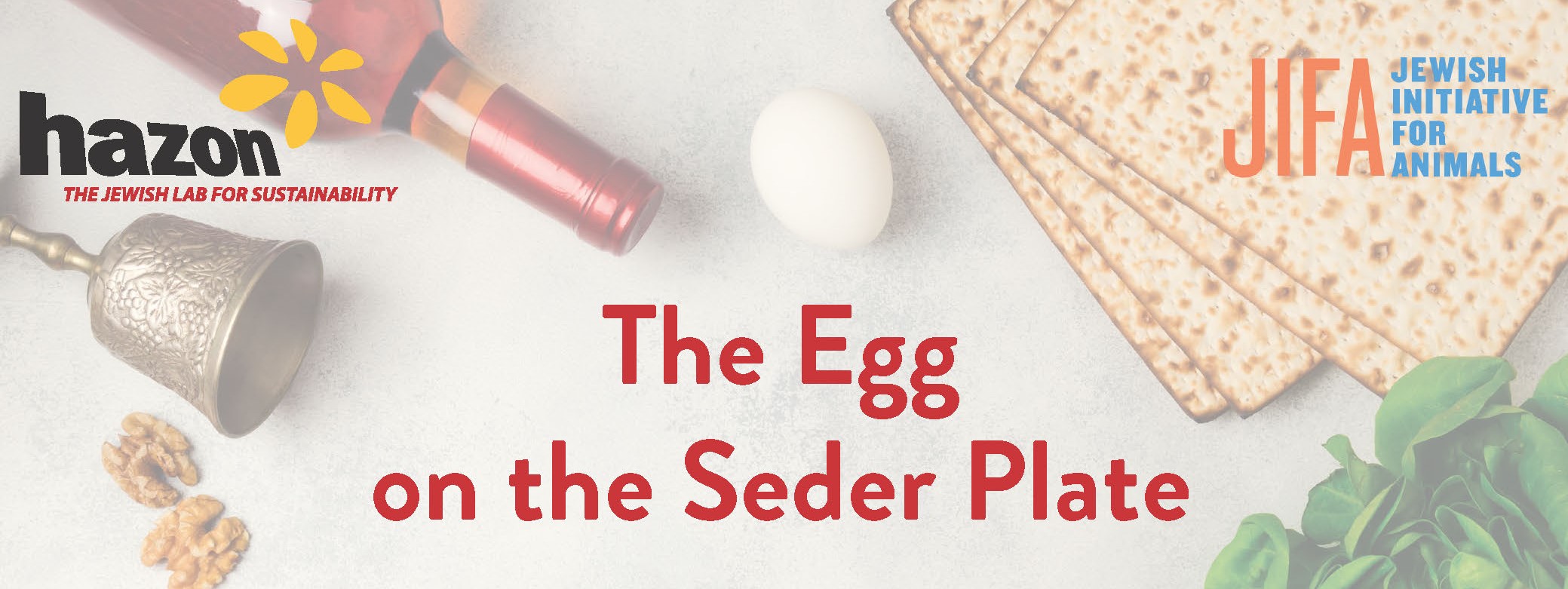Passover (Pesach) celebrates the exodus of the Israelites from Egypt.
For 8 days starting on the 15th of Nissan, we celebrate our liberation from slavery and our journey to freedom.
On the first night of Passover we remember the sacrifice of lamb and on the second night the sacrifice of barley – each to remind us of temple celebrations that connect us to the land of Israel. Passover is a time to notice and celebrate the coming of spring. The seder plate abounds with seasonal symbols: the roasted lamb bone celebrates lambs born in spring; karpas (dipped green vegetables) symbolizes the first green sprouts peeking out of the thawed ground, and a roasted egg recalls fertility and rebirth.
Make your Passover more sustainable using the resources, tips & recipes below.
Activities & Rituals
Host a chocolate seder. Use this Haggadah supplement for a discussion around sustainability, worker justice, and related food issues.
Matzah Making: Students will learn how to make flour from wheat and make matzah from the flour.
Bread of Affliction: Matzah, Hunger, and Race. Use this Haggadah supplement as a conversation guide to explore the relationship between vulnerable communities and lack of access to nutritious food.
Passover in the Desert: 2nd Night Seder Youth Skit: an off-the-page co-created celebration around the bonfire!
Food and Justice. The Uri L’Tzedek Food and Justice Haggadah Supplement features essays, insights and action to unite food, social justice, and ethical consumption.
Food Blessings. Recount the many food blessings in Jewish tradition. Invite each guest to offer a food blessing – either traditional and original, This is a good way to consider all of the food that we will eat together during the Pesach seder, and what the significance may be to each individual at the table.
Place an ice block on your seder table. Open up a conversation about the climate crisis, while linking it to the fundamental themes of Pesach and Jewish community life. As the ice block melts throughout the seder, it becomes a physical prompt to ask questions, much like many of the other items on the seder table.
What Would Moses Do? Moses brought the enslaved Jews out of Egypt towards freedom. Sadly, a different form of slavery exists today, both in Israel and the rest of the world. According to estimates by NGOs, a few hundred to a few thousand people have been illegally trafficked into Israel for sexual exploitation or labor. Approximately 70% of these sex workers are women. Refer to Fair Trade Judaica’s Seder Resources to educate your guests about the slavery that exists in the world today.
Sustainability Tips
Pre-Passover Green Cleaning. You don’t have to douse your house in poisonous chemicals—noxious to both you and the people who work in the factories that produce them—to get rid of your chametz (bread products and crumbs which are literally, and ritually, cleared before Pesach). Try using natural, non-toxic cleaning products instead of your traditional harsh chemicals.
Plan ahead. In the time leading up to Pesach, be mindful of what you buy. Try to finish those “almost empty” containers in your fridge, and half empty bags of bread, rather than automatically resorting to buying new. You can get rid of chametz in the most sustainable and cost effective way by planning ahead in order to use up as much as you can of what you have before the start of Pesach.
Invest in Pesach Dishware. Pesach is a time when many families break out the fancy dishes and heirloom silverware. Investing in a set of Pesach dishware, is a sustainable commitment to avoid buying disposables every year. If you’re using disposable plates this year, use post-consumer waste paper or plant-based ones.
Get rid of ALL your chametz. Chametz isn’t just leavened bread – it is a symbol for all the unnecessary waste that fills up our lives. While you’re getting rid of breadcrumbs, read the ingredients on your food. All those sauces that are different versions of sugar – do you really need them? If you’re feeling brave: cut out caffeine and all processed foods, and maybe give up booze for good measure. Your body will thank you. You’ll go into Pesach feeling strong and clean.
What’s your existential chametz? Start journaling. What’s the fluff, the stuff, the superfluity, that clogs up your brain, that stops you being free?
Enjoy your flowers on Pesach—and all spring. Fresh bouquets make beautiful centerpieces, but only last a few days, and are often grown with pesticides. Try a sustainable alternative like potted tulips. Potted herbs also make a beautiful, inexpensive centerpiece, and make your table smell great! You can buy potted thyme, rosemary, lavender, and other fragrant herbs at a garden nursery or farmer’s market. At the end of the seder, give your centerpieces as gifts to your guests. If you definitely want cut-flower centerpieces, go organic!
A Sustainable Seder Plate
Higher Welfare beytza (egg). Buy eggs that are labeled “Certified Humane” or, even better “Certified Humane + Pasture Raised” or “Animal Welfare Approved.” Buying eggs with these third-party certifications means supporting healthy hens and farmers who are making it possible for you to eat good food. Discuss your decision to buy a higher welfare egg at your Seder using Hazon’s higher welfare egg Haggadah supplement.
Sprout your own Karpas. If you can’t find locally grown greens to dip for karpas, sprout your own! Although many sprouts come from corn, soybeans, and other chametz or kitnyot, in just 2-3 days, you can have fresh, delicious quinoa sprouts that you “grew” yourself! If you started a home-grown garden during Tu B’Shvat, now is the time to dig into that garden and make use of your home grown parsley.
Horseradish doesn’t grow in a bottle. Buy and grate fresh horseradish root for maror on your seder plate. When it comes time for the Hillel sandwich, hold up an ungrated root so your guests know where that bitter stuff comes from. You can also incorporate horseradish into your seder in other ways, or use leftover horseradish for meals throughout Passover.
Roast a beet. If you’re going vegetarian for your seder (see below), substitute a roasted beet for the roasted lamb shank. Or follow Sarah Fenner’s suggestion: “In place of the shankbone in my home, we have often roasted a “pascal yam” instead!”
Every Charoset tells a story. Charoset’s mixture of apples and nuts is already healthy and delicious and, when made with local apples, sustainable. Charoset also offers you the chance to explore other cultures within the Jewish Diaspora. Or ask your guests to bring their own favorite charoset recipe and have a taste-test.
A Sustainable Seder Meal
Host a vegetarian or vegan seder. Even if you regularly eat meat, Passover is a great time to eat lower on the food chain. Think of it as getting rid of your “gastronomical chametz.”
Recipes:
The Shamayim blog has an incredible bank of resources and recipes for a vegan seder.
Jewish Veg has a Vegan Haggadah and loads of Passover recipes on their website.
Host a potluck seder. Or at least accept offers of help with the preparation. A sustainable seder also means not wearing out the host!
Bring on the hors d’oeuvres. After you bless and eat the karpas, vegetables and dip, fruits, and cheese are all permitted. Save your table from starvation and distraction with a few snacks – everyone will have a better time.
Buy vegetables at your farmer’s market. Go a few weeks early and chat with the sellers to see what they’ll have available at seder time. In many parts of the country, options will be slim, but you may find salad greens, cabbage, fiddleheads, spinach, as well as root vegetables in cold storage (carrots, potatoes, onions, squash, beets) and apples and pears. Consider making at least one dish from all local ingredients and feature it at your seder.
Serve local and/or organic wine. Find out ahead of time what your local wine store has in stock—especially if you plan to buy a lot of bottles. If they don’t have anything, ask them to order a case on your behalf. There aren’t many kosher organic wines available, but one or two are Kosher for Pesach. Consider paying a little more at a locally-owned store; sustainable means supporting local businesses, too.
Serve local/ethically-sourced meat. Meat dishes like chicken soup with matzah balls and brisket are traditional favorites for Passover. Try buying your meat from the person who raised it (or as close to that as possible. Where to shop: farmer’s markets, meat co-ops, local butcher shops (ask them where the meat comes from).
More Resources
Food for Thought– A 130-page sourcebook that draws on a range of texts from within and beyond Jewish traditions to explore a range of topics relating to Jews and food.
Adamah Blog
- Journey to a More Sustainable Passover
- 10 Ways to Make your Passover More Sustainable
- This Passover, Take Action for the Climate
Programs & Workshops
- Clearing Out the Old to Make Room for the New: A Passover Tradition
- Beyond Horseradish: Exploring Maror
- Post-Pesach Wild Edibles Hike
- Passover on the Farm
- The ECO Passover connection
My Jewish Learning – Passover 101
The Forward


